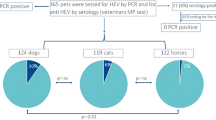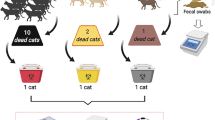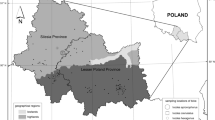Abstract
THE transmission of feline leukaemia virus (FeLV) horizontally among cats has been well established1–3 but the source of infectious virus responsible for this transmission has not been determined, C-type particles resembling FeLV have been seen by electron microscopy in many tissues and body fluids from cats having leukaemia and lymphoma4–7. In reference to potential environmental excretion, particles have been seen in the upper and lower respiratory tract, saliva, urine, gut wall, and peripheral blood. These studies, however, have been limited to electron microscopic visualisation and have not studied levels of infectious FeLV in tissues or fluids which could release virus into the environment. Speculation about the source of infectious virus has included urine saliva, fleas, and blood (from either scratches, bites, or blood sucking arthropods)1,8.
This is a preview of subscription content, access via your institution
Access options
Subscribe to this journal
Receive 51 print issues and online access
$199.00 per year
only $3.90 per issue
Buy this article
- Purchase on Springer Link
- Instant access to full article PDF
Prices may be subject to local taxes which are calculated during checkout
Similar content being viewed by others
References
Essex, M. Adv. Cancer Res. 21, 175 (1975).
Hardy, W. D., Jr, et al. Nature 244, 266 (1973).
Jurrett, W. et al. J. natn. Cancer Inst. 51, 833 (1973).
Dougherty, E., Post, J. E. & Rickard, C. G. Can. Vet. J. 10, 291 (1969).
Gardner, M. B., Rongey, R. W., Johnson, E. Y., DeJournett, R. & Huebner, R. J. J. natn. Cancer Inst. 47. 561 (1971).
Hardy, W. D., Jr, et al. Science 166, 1019 (1969).
Laird, H. M., Jarrett, O., Crighton, G. W. & Jarrett, W. F. H. J. natn. Cancer Inst. 41, 867 (1968).
Hardy, W. D., Jr, et al. in Compartaive Lenkemia Research (eds Ito, Y. & Dutcher, R. M.) 67 (University of Tokyo Press, Tokyo, 1975).
Schneider, R. Int. J. Cancer. 10, 338 (1972).
Hanes, B. et al. J. natn. Cancer Inst. 45, 1155 (1970).
Bross, I. D. J. & Gibson, R. J. Med. Exp. Clin 1, 180 (1970).
Essex, M. & Francis, D. P. J. Am. Animal Hosp. Ass. 12, 386 (1976).
Biologie Safety Manual for Research Involving Oncogenic Viruses. National Cancer Institute, 3 October, 1974.
Essex, M. et al. J. natn. Cancer Inst. 54, 637 (1975).
Fischinger, P., Blevins, C., Nomuro, S. J. Virol. 14. 177 (1974).
Schneider, R. Int. J. Cancer 10, 345 (1972).
Jarrett, W. F. H. Adv. Vet. Sci. Comp. Med. 19, 165 (1975).
Essex, M., Hardy, W. D., Jr, Cotter, S. M., Jakowski, R. M. & Sliski, A. Inf. Immunity 11, 470 (1975).
Cotter, S. M., Essex, M. & Hardy, W. D. Jr Cancer Res. 34, 1061 (1974).
Jarrett, W. F. H. Bibl. Haemat. 43, 209 (1975).
Author information
Authors and Affiliations
Rights and permissions
About this article
Cite this article
FRANCIS, D., Essex, M. & HARDY, W. Excretion of feline leukaemia virus by naturally infected pet cats. Nature 269, 252–254 (1977). https://doi.org/10.1038/269252a0
Received:
Accepted:
Issue Date:
DOI: https://doi.org/10.1038/269252a0
Comments
By submitting a comment you agree to abide by our Terms and Community Guidelines. If you find something abusive or that does not comply with our terms or guidelines please flag it as inappropriate.



